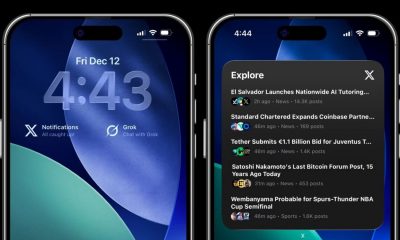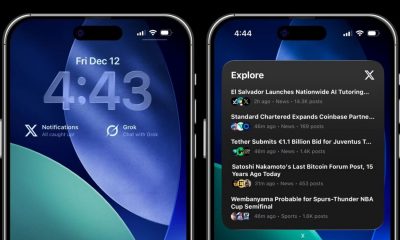

De-fi
Tokenized Equity Market on Hyperliquid Heats Up – Crypto News
TradeXYZ, Felix, and Ventuals all released new HIP-3 markets on Hyperliquid today, including tokenized NVDA, TSLA, and SPACEX.
Less than a month after TradeXYZ deployed tokenized Nasdaq futures (XYZ100) on Hyperliquid, multiple protocols have launched TSLA, NVDA, and SPACEX perpetuals over the last 24 hours.
TradeXYZ, the permissionless perpetual arm of Unit, the Hyperliquid tokenization layer, kicked off the gold rush yesterday with the launch of tokenized NVDA. Today, Felix Protocol and TradeXYZ followed suit with TSLA, and Ventuals launched SPACEX.
XYZ100 still leads the HIP-3 sector in total volume and open interest by a landslide, but TradeXYZ’s NVDA and TSLA markets are ramping up, generating $26 million in 24-hour volume and almost $9 million in open interest between them.
A notable difference between TradeXYZ’s markets and those deployed by Felix and Ventuals is that the XYZ markets are denominated in USDC, the dominant stablecoin on Hyperliquid, while Felix and Ventuals settle in USDH, Native Markets’ recently launched stablecoin.
This move marks the first true source of demand for USDH, which will funnel 50% of the yield on its reserves towards buying HYPE tokens.
All new markets have been launched with low open interest caps, which are expected to be raised over time as the teams continue to monitor their performance.
Scaling and Distribution in HIP-3 Markets
Charlie, a contributor at Felix Protocol, spoke to The Defiant about new HIP-3 developments, including liquidity fragmentation across markets that represent the same tokenized equity, and how the market can expect HIP-3s to grow beyond a crypto-native audience.
He said there is currently an overlap between Unit and Felix, both of which offer tokenized TSLA markets. However, this overlap is set to diverge as Felix develops separate businesses that do not rely just on Hyperliquid’s UI as the main TSLA/USDH distribution source.
Charlie added that using USDH offers several advantages, including 20% lower taker fees, 50% higher rebates, and 20% higher volume contributions. “This means it should be cheaper and more liquid for you to trade the same market on Felix – additionally, our fee schedule will be lower as well. So the primary differentiator out of the gate between Felix and Unit is cost.”
While HIP-3 perpetual markets are still in their infancy, even in crypto-native use cases, teams are looking to expand the HIP-3 funnel and attract traditional finance traders as well.
“I think this [distribution to non-crypto audiences] will primarily come down to regulatory clarity and distribution, and the two play into one another. Once one major player starts integrating perps and then equity perps due to customer demand, regulatory clarity follows.”
“On the distribution side, non-crypto-natives likely do not want to go through the complexities of wallet management, etc, to trade these markets. That’s where something like a Privy + Hyperliquid builder code integration into a known interface like Bloomberg bridges the gap,” Charlie concluded.
-
others6 days ago
Japan Foreign Investment in Japan Stocks up to ¥528.3B in December 12 from previous ¥96.8B – Crypto News
-

 Technology1 week ago
Technology1 week agoApple iPhone 16 Pro price slashed by up to ₹40,000 on Flipkart? Here’s how to grab the deal – Crypto News
-

 Technology6 days ago
Technology6 days agoOnePlus 15R vs Pixel 9a: Which phone is the best buy under ₹50,000? Display, camera, processor and more compared – Crypto News
-

 Blockchain4 days ago
Blockchain4 days agoThis Week in Stablecoins: Winning the Back Office – Crypto News
-

 Blockchain1 week ago
Blockchain1 week agoJPMorgan Prepares to Launch First Tokenized Money Market Fund – Crypto News
-

 others5 days ago
others5 days agoAustralian Dollar loses as US Dollar advances before Michigan Sentiment Index – Crypto News
-

 Blockchain1 week ago
Blockchain1 week agoBitcoin Macro Retracement Meets Mid-Range Battle – Crypto News
-

 others1 week ago
others1 week agoGBP/USD drops as UK GDP shrinks for second straight month – Crypto News
-

 Technology1 week ago
Technology1 week agoMicrosoft AI boss Suleyman calls Elon Musk a ‘bulldozer’, labels Sam Altman ‘courageous’ – Crypto News
-

 Technology1 week ago
Technology1 week agoElon Musk’s X rolls out home and lock screen widgets for iPhone and iPad users – Crypto News
-

 Cryptocurrency1 week ago
Cryptocurrency1 week agoBlockworks launches investor relations platform with Solana – Crypto News
-
Business3 days ago
XRP Holders Eye ‘Institutional Grade Yield’ as Ripple Engineer Details Upcoming XRPL Lending Protocol – Crypto News
-

 Technology3 days ago
Technology3 days agoApple iPhone 16 price drops to ₹40,990 in Croma’s Cromtastic December Sale: How the deal works – Crypto News
-

 Cryptocurrency1 week ago
Cryptocurrency1 week agoBTC is up and L1s are down as flows turn messy again – Crypto News
-

 Blockchain1 week ago
Blockchain1 week agoWhy Twenty One’s First-Day Slide Shows Waning Appetite for BTC Firms – Crypto News
-

 Blockchain1 week ago
Blockchain1 week agoAave DAO Community Clashes With Aave Labs Over CoW Swap Fees – Crypto News
-

 Technology1 week ago
Technology1 week agoElon Musk’s X rolls out home and lock screen widgets for iPhone and iPad users – Crypto News
-
Business1 week ago
Bitcoin Faces Slide Towards $70K as Japan Rate Hike Odds Spike – Crypto News
-

 Cryptocurrency1 week ago
Cryptocurrency1 week agoTranshumanism Branded a ‘Death Cult’ as Thinkers Clash Over Humanity’s Future – Crypto News
-

 Technology1 week ago
Technology1 week agoUS Puts Tech Deal With UK on Hold – Crypto News
-

 Blockchain1 week ago
Blockchain1 week agoCiti Says Identity Is the New Gatekeeper for Financial Blockchains – Crypto News
-

 Blockchain6 days ago
Blockchain6 days agoBitcoin on Track For 4th Annual Decline Despite Crypto Adoption – Crypto News
-
Business4 days ago
DOGEBALL Presale: A Boost to Bring P2E Games Back into the Spotlight – Crypto News
-
Business4 days ago
125 Crypto Firms Mount Unified Defense as Banks Push to Block Stablecoin Rewards – Crypto News
-

 Technology3 days ago
Technology3 days agoApple iPhone 16 price drops to ₹40,990 in Croma’s Cromtastic December Sale: How the deal works – Crypto News
-

 Blockchain3 days ago
Blockchain3 days agoLitecoin Follows Bitcoin’s Momentum, But Resistance Looms At $79.60 – Crypto News
-

 Blockchain1 week ago
Blockchain1 week agoCrypto Use in Venezuela Likely to Rise as Economic Pressures Intensify – Crypto News
-

 Cryptocurrency1 week ago
Cryptocurrency1 week ago$350B in crypto losses – But big Bitcoin buyers are moving in – Crypto News
-

 others1 week ago
others1 week agoCopper hits record near $12,000 – Commerzbank – Crypto News
-
others1 week ago
Will Bittensor Price Break Above $400 After First TAO Halving Tomorrow? – Crypto News
-

 Cryptocurrency1 week ago
Cryptocurrency1 week agoDollar dominance can’t be manufactured – Crypto News
-

 Blockchain1 week ago
Blockchain1 week agoXRP Holders Labeled ‘Uneducated Perma Bulls’ By Veteran Trader – Crypto News
-
Business1 week ago
Bitcoin Faces Slide Towards $70K as Japan Rate Hike Odds Spike – Crypto News
-

 Technology1 week ago
Technology1 week agoSamsung tipped to raise Galaxy A series price in India starting Monday: here’s what to expect – Crypto News
-
others1 week ago
Metaplanet CEO Teases “Crucial” Bitcoin Buy Decision at Upcoming EGM, Stock Wavers – Crypto News
-

 Cryptocurrency1 week ago
Cryptocurrency1 week agoXRP Price Analysis for December 14 – Crypto News
-

 Cryptocurrency1 week ago
Cryptocurrency1 week agoCapital gets selective – Blockworks – Crypto News
-
others1 week ago
Low-Fee vs. High-Leverage – How to Choose the Optimal Exchange for Your Trading Strategy? – Crypto News
-

 Cryptocurrency1 week ago
Cryptocurrency1 week agoBitcoin and Ethereum Wobble as US Reports Highest Unemployment Rate Since 2021 – Crypto News
-

 others7 days ago
others7 days agoJapanese Yen strengthens as BoJ rate hike speculation grows – Crypto News
-

 Blockchain6 days ago
Blockchain6 days agoBlockchain’s Institutional Future Is Private and Permissioned – Crypto News
-

 Cryptocurrency5 days ago
Cryptocurrency5 days agoWhy quantum computing is becoming a real concern for Bitcoin – Crypto News
-
Business4 days ago
Bitcoin Price Alarming Pattern Points to a Dip to $80k as $2.7b Options Expires Today – Crypto News
-
Business3 days ago
Ethereum Faces Selling Pressure as BitMEX Co-Founder Rotates $2M Into DeFi Tokens – Crypto News
-
others3 days ago
XRP Holders Eye ‘Institutional Grade Yield’ as Ripple Engineer Details Upcoming XRPL Lending Protocol – Crypto News
-

 Technology3 days ago
Technology3 days agoApple iPhone 16 price drops to ₹40,990 in Croma’s Cromtastic December Sale: How the deal works – Crypto News
-

 Blockchain3 days ago
Blockchain3 days agoCrypto Market Sentiment Not Fearful Enough For Bottom: Santiment – Crypto News
-

 Blockchain3 days ago
Blockchain3 days agoCrypto Market Sentiment Not Fearful Enough For Bottom: Santiment – Crypto News
-

 Cryptocurrency1 week ago
Cryptocurrency1 week agoThese Bleak Victim Letters Helped Seal Terra Founder Do Kwon’s Fate – Crypto News
-

 others1 week ago
others1 week agoGBP faces headwinds despite budget relief – Rabobank – Crypto News


















